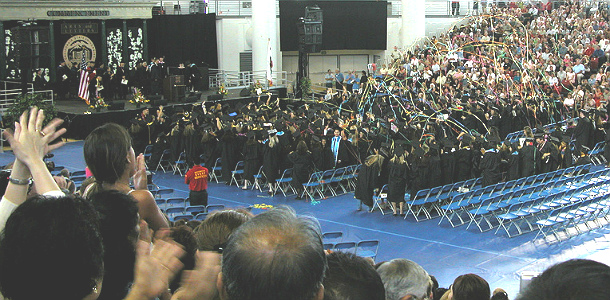
California State University, San Bernardino graduation. (Photo Credit: Doug Carlson/Flickr)
The Budget Act of 2014 appropriates $50 million in one-time resources from the General Fund for the Awards for Innovation in Higher Education. Five campuses were awarded the maximum prize of $5 million each and CA Fwd has featured them in a weeklong series. California State University San Bernardino was honored and its President, Tomas Morales agreed to share some thoughts about their innovation.
CA Fwd: Briefly describe what your innovation was designed to do?
Tomas Morales: “CSUSB and the University of California, Riverside (UCR) formed a bi-county K-20, cross sector collaborative to address college readiness and ultimately increase baccalaureate degree attainment in our region, particularly among underrepresented groups. Across San Bernardino and Riverside Counties, our education, non-profit, and business leaders have come together to create a cradle-to-career collective impact model through which we develop targeted, coordinated programmatic interventions. Our vision for this systemic innovation is to promote and improve education for all students, significantly benefiting the local economy through preparation of a well-trained workforce. Among our goals are to:
- Increase college preparedness, particularly in math, resulting in a 20 percent reduction in number of students requiring remediation at matriculation from high school to college within 5 years.
- Increase baccalaureate attainment by 15 percent across the two counties within 5 years.
- Improve career preparedness through strengthened partnership with industry to better align education with workforce development needs.”
CA Fwd: These innovations take partnerships–who did you work with and why was that important to its success?
Tomas Morales: “The collaborative includes active participation from approximately 175 leaders of various sectors. Through partnership with Inland Empire Economic Partnership (IEEP), The Federation for A Competitive Economy (FACE), and the Coachella Valley Economic Partnership the coodination between higher education institutions, K-12 education, government, media, healthcare, business, and community-based organizations occurs to establish an effective P-20 continuum to promote academic success.
“These collaborations are critical, because of the shared recognition that all parts of the continuum needed to be coordinated and improved at the same time, and that no one institution can address the educational attainment issues in our region alone. To overcome the educational and economic challenges, it is critical to take a regional multi-stakeholder approach to stimulating economic vitality and furthering quality of life by increasing the college going/completion and career readiness of local youth. Through the engagement of members of the collaborative, specific strategic initiatives have been developed and launched over the past few years. We aren’t done. Planning for future collaborative work is underway to create a regional system of best practices for access, retention and degree completion.”
CA Fwd: What did you learn?
Tomas Morales: “Three things: (1) the educational problems in this region are systemic and cannot be fixed piecemeal fashion—it must be a holistic approach to P-20 educational reform; (2) the only way to have authentic collaboration among groups that may be competitors for resources or have disparate interests is to have a unifying vision, mission and set of goals that motivates and focuses the efforts of all stakeholders; (3) trust is maintained among such a large and diverse group by maintaining transparency.”
CA Fwd: What data and analytic(s) have you used to assess the impact of this work and have they helped?
Tomas Morales: “One fundamental tenant undergirding the collective impact model we have developed is the value of data-driven decision making. Rigorous assessment is built into virtually every innovation that we have discussed in this proposal. Within CSUSB, the rigorous monitoring and forecasting analytics of our Office of Institutional Research and of Admissions & Student Recruitment are used to carefully monitor the impact of these new programs such as the guaranteed admission policies to prepare for mitigate any unforeseen negative consequences.
In terms of our regional efforts, the collective impact model is in the early stages of development. As we create the sustainable structure that the Innovation Fund Award is allowing us to build, we are explicitly imbedding data collection and assessment processes to monitor the effectiveness of our innovations. Creation and enhancement of a regional data sharing and data analytic system is one of the priorities we described in our proposal.”
CA Fwd: How will you sustain the innovation that you were awarded for?
Tomas Morales: “The membership of this regional collaborative is composed of the top leaders of our educational institutions, industry, and other related sectors. The members participate voluntarily because of their shared interest and concern for the citizens and future of the Inland Empire. The recognition of the unique challenges and strengths of our region and the dedication to creating and sustaining tailored interventions that address those issues is what unites these diverse groups. The leaders of our region recognize that they much use their resources wisely and ensure coordinated non-duplicative effort is targeted toward our greatest educational and economic needs if we are to achieve parity with some of our more well-resourced neighbors. Participation in the strategic dialogue itself is a low-cost method for leaders to align their efforts, create synergy rather than duplicative investments, and share in collective impact strategies.
“In addition to using our existing operational budgets of the collaborating partners for such innovative programs and practices, each institution also actively seeks external funds to supplement the costs of the work we undertake.”
CA Fwd: What could the state do to make it easier to encourage innovation in higher education (and other parts of state government)?
Tomas Morales: “The development of a consistent funding source like this one could pay great dividends for the state, requiring partnerships and collaboration that could impact every level of education.”

